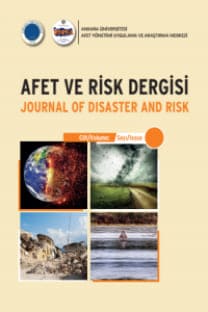Nükleer Santrallerde Yangın Güvenliği Açısından Reaktör Soğutmanın Önemi ve Fukuşima Daiichi Kazası Modeli Üzerinden Kontrol Dışı Gerçekleşen Fisyon Reaksiyonlarının Enerjisinin Hesaplanması
Bu makalede nükleer enerji santrallerinde patlamanın
oluşmasına neden olan durumlar değerlendirilerek, kontrol dışı gerçekleşen
fisyon reaksiyonları sonucu açığa çıkan
enerjinin hangi durumlara neden olabileceği
araştırılmıştır. Model olarak ele alınan Fukuşima Daiichi Nükleer santralinde
soğutma sistemi doğal afet nedeni ile devre dışı kalan üç ünitedeki
reaktörlerde, üç gün içinde devam eden fisyon reaksiyonları sonucu açığa çıkan
enerjinin hesaplanması için W.s’lik enerji elde etmek için gereken fisyonların
sayısı bulunmuş, daha sonra bu enerjinin oluşabilmesi için kullanılması gereken
U-235 kütlesi hesaplanarak toplamda üç reaktör için 2028 MW/h enerji üretimi
miktarı baz alınarak harcanan U-235 kütlesi hesaplanmış ve 67 saat süre sonunda
ortamda kontrolsüz olarak oluşacak enerji, sonuçlarının değerlendirilebilmesi
için hesaplanmıştır. Hesaplamalara göre 3,4273 kg U-235 harcanması sonucu 2028
MW/h enerji açığa çıkmıştır. Bu
enerjinin santralde yaşanan patlama olayına hangi şartlarda neden olduğu
açıklanmıştır.
Anahtar Kelimeler:
Nükleer Güç Santralleri, Yangın, Patlama, Nükleer Enerji
The Importance of Reactor Cooling For Fire Safety in Nuclear Power Plants And Calculation of The Energy of Uncontrolled Fixation Reactions Via Fukushima Daiichi Accident Model
The residual heat and
fission reactions caused by the failure of safety systems and backup
generators after natural disaster in Fukushima Daiichi accident caused an
explosion in the power plant. In this article, the energy that causes the
explosion is calculated and the possible negative effects of this energy is
explained. The number of fusions required to obtain W energy has been
found to be able to calculate the
energy released by fission reactions
within three days in the reactors in the three units that have been disabled
due to natural disaster at the cooling
system of the Fukushima Daiichi nuclear power plant. Then, the mass of U-235,
which is calculated based on the amount of energy production of 2020 MW / h for
three reactors, was calculated by calculating the mass of U-235 which should be
used to form this energy, and after 67 hours, uncontrolled energy in the
environment was calculated to evaluate the results. According to the
calculations, an energy consumption of 3,4273 kg U-235 resulted in 2028 MW / h
energy and in joule it was found to be 2028000 Kj/h. It was explained how this
energy caused the explosion in the plant.
This
research; it is aimed to contribute to the future studies and to take measures
against the situations that cause the explosion in nuclear power plants.
Keywords:
Nuclear Power Plants, Fire, Explosion, Nuclear Energy,
___
- Cebe, M. (2014). Fizikokimya 1, Ekin Kitabevi Yayınları, Cilt II.
- Gunter, P. (2004). Natural Disasters and Safety Risks at Nuclear Power Stations. NIRS (Nuclear Information and Resource Service). Washington, DC. USA.
- Güler, T. (2006). Nükleer Enerji Üretim Sürecinde Kazalar, Nükleer atıklar ve Çevre Sorunları. Yayınlanmamış Yüksek Lisans Tezi. Ankara. Gazi Üniversitesi Sosyal Bilimler Enstitüsü Kamu Yönetimi.
- Keski-Rahkonen, O., Mangs, J. (2002). Electrical ignition sources in nuclear power plants: Statistical, modeling and experimental studies. Nuclear Engineering and Design.
- Özbay, E. ve Gençoğlu M. T. (2011). Küçük Hidroelektrik Santrallerde Yük-Frekans Kontrolü. Fırat Üniverstesi Mühendislik Bilimleri Dergisi, 23 (2), 119-128.
- Mühendis ve makine Dergisi, Cilt 53, Sayı 626, Technical report: Fukushima Accident Summary (Aug. 19, 2011) Ritsuo Yoshioka, Kenji Lino. (çeviri Yeliz Demir) URL 1, http://kurumsalarsiv.taek.gov.tr/bitstream/1/101/2/30008.pdf (Son Erişim: 01.02.2019).
- URL 2, https://www.taek.gov.tr/tr/2016-06-09-00-43-55/135-gunumuzde-nukleer-enerji-rapor/835-bolum-05-nukleer-guvenlik.html (Son Erişim: 01.02.2019).
- URL 3, https://www-pub.iaea.org/MTCD/Publications/PDF/INES_web.pdf (Son Erişim: 01.02.2019).
- URL 4, https://pris.iaea.org/PRIS/WorldStatistics/UnderConstructionReactorsByCountry.aspx (Son Erişim: 01.02.2019)
- URL 5, http://climatesceptics.org/ines-level/table Climate Skeptics. (2013). “Nuclear Power in Europe”, (Son Erişim: 01.02.2019).
- Vinod, G., Saraf, R. K., Ghosh, A. K., Kushwaha, H. S., & Sharma, P. K. (2008). Insights from fire PSA for enhancing NPP safety. Nuclear Engineering and Design, 238(9), 2359-2368.
- Yayın Aralığı: Yılda 4 Sayı
- Başlangıç: 2018
- Yayıncı: Ankara Üniversitesi
Sayıdaki Diğer Makaleler
Hüseyin BAYRAKTAR, Elif SAHTİYANCI, Ali KURU
Antropojenik İklim Değişikliğine Bağlı Deniz Seviyesi Değişiminin Sinop Yarımadası’na Olası Etkileri
Yozgat Çamlığı Milli Parkı’nın Özellik ve Gizemleri
Kırsal Yoksulluk, Göç ve Afet İlişkisi “Zeytinköy Orman Yangını Örneği”
Muskingum Yönteminin Sürtünme Katsayısına (n) Bağlı Performans Analizi
